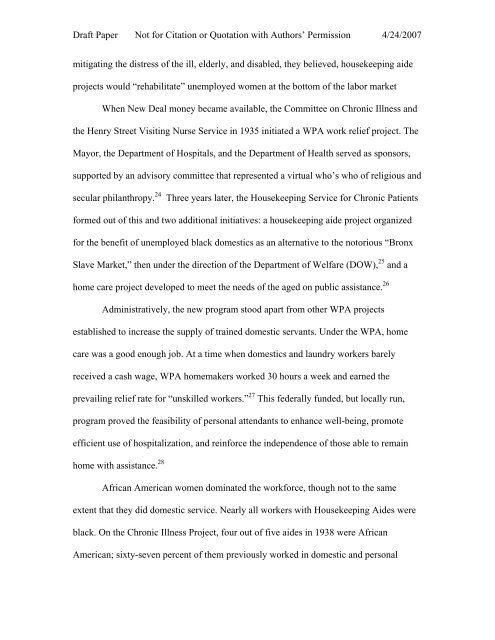Organizing Home Care: - School of Social Service Administration
Organizing Home Care: - School of Social Service Administration
Organizing Home Care: - School of Social Service Administration
Create successful ePaper yourself
Turn your PDF publications into a flip-book with our unique Google optimized e-Paper software.
Draft Paper Not for Citation or Quotation with Authors’ Permission 4/24/2007<br />
mitigating the distress <strong>of</strong> the ill, elderly, and disabled, they believed, housekeeping aide<br />
projects would “rehabilitate” unemployed women at the bottom <strong>of</strong> the labor market<br />
When New Deal money became available, the Committee on Chronic Illness and<br />
the Henry Street Visiting Nurse <strong>Service</strong> in 1935 initiated a WPA work relief project. The<br />
Mayor, the Department <strong>of</strong> Hospitals, and the Department <strong>of</strong> Health served as sponsors,<br />
supported by an advisory committee that represented a virtual who’s who <strong>of</strong> religious and<br />
secular philanthropy. 24<br />
Three years later, the Housekeeping <strong>Service</strong> for Chronic Patients<br />
formed out <strong>of</strong> this and two additional initiatives: a housekeeping aide project organized<br />
for the benefit <strong>of</strong> unemployed black domestics as an alternative to the notorious “Bronx<br />
Slave Market,” then under the direction <strong>of</strong> the Department <strong>of</strong> Welfare (DOW), 25 and a<br />
home care project developed to meet the needs <strong>of</strong> the aged on public assistance. 26<br />
Administratively, the new program stood apart from other WPA projects<br />
established to increase the supply <strong>of</strong> trained domestic servants. Under the WPA, home<br />
care was a good enough job. At a time when domestics and laundry workers barely<br />
received a cash wage, WPA homemakers worked 30 hours a week and earned the<br />
prevailing relief rate for “unskilled workers.” 27 This federally funded, but locally run,<br />
program proved the feasibility <strong>of</strong> personal attendants to enhance well-being, promote<br />
efficient use <strong>of</strong> hospitalization, and reinforce the independence <strong>of</strong> those able to remain<br />
home with assistance. 28<br />
African American women dominated the workforce, though not to the same<br />
extent that they did domestic service. Nearly all workers with Housekeeping Aides were<br />
black. On the Chronic Illness Project, four out <strong>of</strong> five aides in 1938 were African<br />
American; sixty-seven percent <strong>of</strong> them previously worked in domestic and personal
















